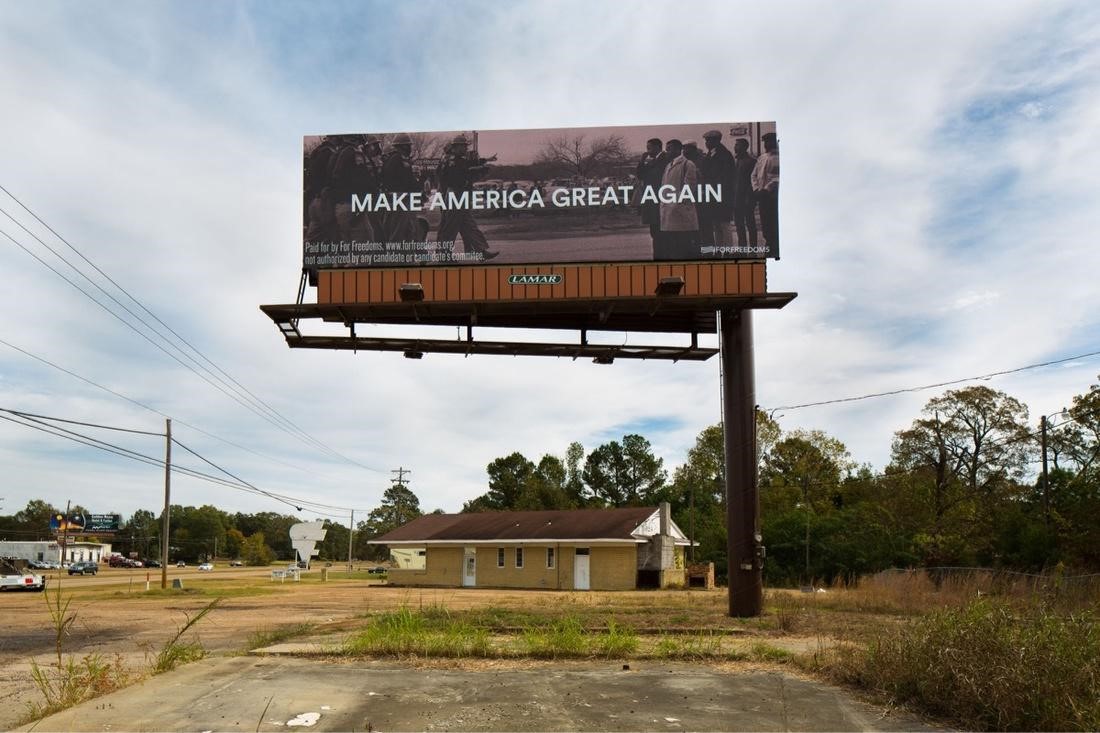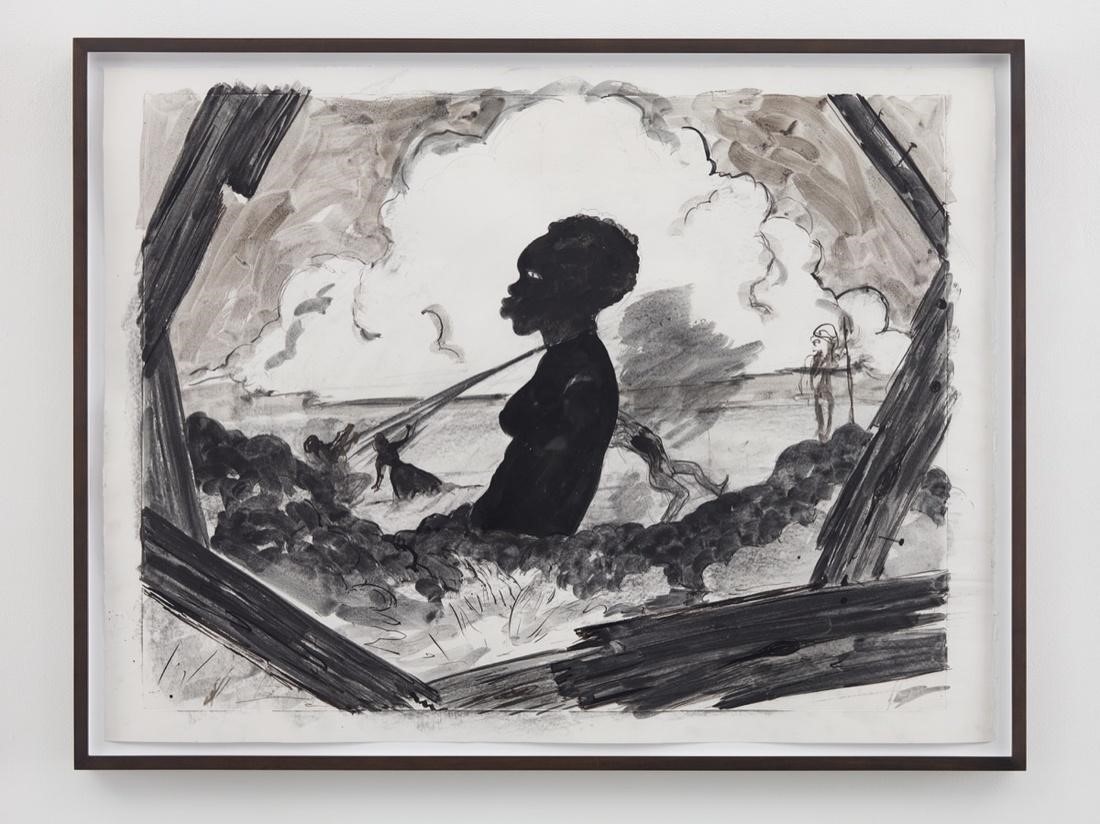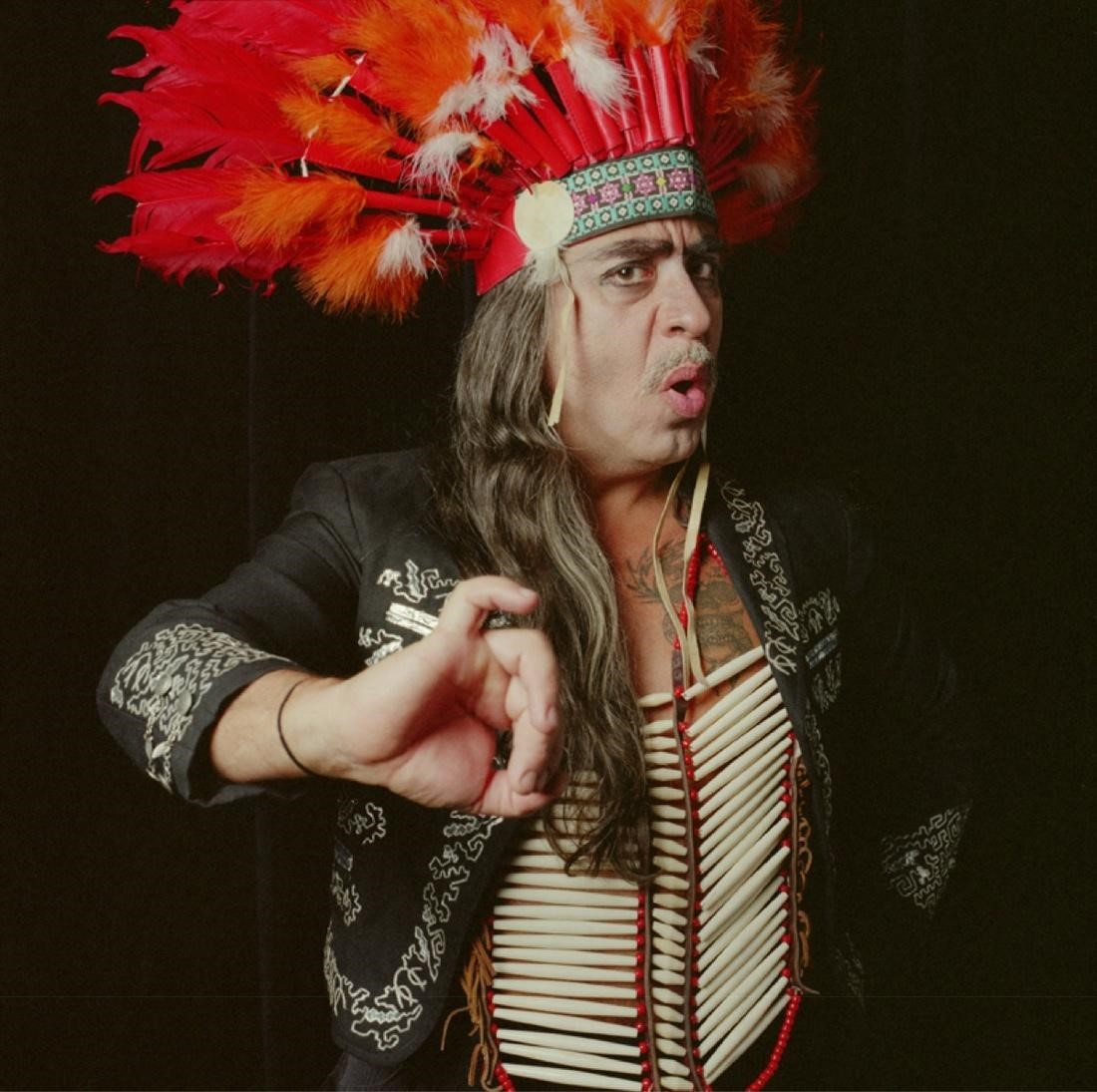20 Artists for the Trump Era
20 Artists for the Trump Era
ARTSY EDITORIAL
JAN 19TH, 2017 11:22 PM
Donald Trump assuming the office of the United States Presidency today is an event few on either side of the political aisle saw coming a few months ago. And so, as many think about the four years after Inauguration Day and ask what is to be done and what comes next, a natural step is to look around and ask, what country do we live in? Many artists are engaging with social practice and other forms of activism that both challenge positions Trump has taken and actively work to craft a better world. Some artists are striking on Inauguration Day as part of the #J20 art action or protesting on the 21st for the Women’s March on Washington (or both). Their efforts will certainly not stop thereafter. But along with being participants in these concrete actions, artists are nothing if not relentless chroniclers and analyzers of the world around us. Much ink has been spilled over the ability of artists to make change, but what is beyond doubt is their ability to help us see.
Grappling with the 45th President and the questions his election raises requires this kind of fundamental reckoning with what the United States actually is and how it came to be this way. Artists provide an indispensable picture: from immigration, to systems of racism, to a declining rust belt, to an expanded surveillance state. Some of what they picture would exist no matter who were taking the oath of office. Below is something of a reading list— admittedly incomplete if only because it is infinite and ever-expanding—of the artists showing us this country and the greater context of the world it exists within. But being moved emotionally is not the same thing as making change. So as we look at their work one hopes it will inspire action to shape a better future.
Pussy Riot
Screen shot from Pussy Riot, Make America Great Again, 2016, via YouTube.
Russian activist art collective and punk rock group Pussy Riot have been outspoken opponents of censorship—a cause that sent three members of the group to jail in 2012 after protesting Vladimir Putin. This time in prison, however, only served to further impassion the group of artists. Since then, they’ve expanded their critique to oppressive governments and policies the world over. Just days before this past November’s U.S. election, the collective released a satirical video on YouTube warning Americans of what they saw as Trump’s exclusionary rhetoric, which could quickly lead to an “erosion of rights.” They’ve also taken to Twitter to amplify their core message of freedom of speech, a right called into question by Trump and his surrogate’s recent insults of press outlets such as The New York Times and CNN.
Ana Teresa Fernández
Ana Teresa Fernandez, Erasing the Border (Borrando la Frontera), 2012. Courtesy of the artist and Gallery Wendi Norris, San Francisco.
Mexican-born artist Fernández breaks down borders in her work—from the physical and psychological boundaries between nations to the dividing lines separating people by race, class, or gender. For a 2011
performance, Borrando la Frontera (“Erasing the Border”), Fernández, clad in cocktail attire, painted portions of the U.S.-Mexico border fence in San Diego a pastel blue, symbolically ridding the landscape of its presence as it disappeared into the sky. Last year, she erased borders in Agua Prieta, Ciudad Juárez, and Mexicali in this same way. With Trump’s promise to build a “great wall” on our southern border with Mexico and to ban immigration for parts of the world, Fernández’s work will find even greater resonance in 2017.
Aliza Nisenbaum
Aliza Nisenbaum, MOIA's NYC Womens Cabinet, 2016. Courtesy James Cohan, New York.
Nisenbaum has gained acclaim in recent years for her figurative paintings that portray undocumented immigrants from Central and South America living in the U.S. Though they are deftly painted and convey the intimate experience of painting from life, these honest portraits also empower hersubjects, challenging politics of visibility and historical conventions around who is represented in a portrait and why. A Mexico City native, Nisenbaum lives in New York where she’s now a professor at Columbia University School of the Arts. The artist recently worked as a fellow at the Mayor’s Office of Immigrant Affairs in New York City, where she painted 15 women working there in powerful group and solitary portraits that evidence art’s ability to penetrate public spheres.
Marilyn Minter
Minter has been fighting for reproductive rights and respect of the female body since the 1970s. It’s a crusade that extends to her paintings andphotographs, which are hyperrealistic depictions of the female form that question the male gaze, homogenizing beauty ideals, and the policing of women’s bodies. This year, as a 2005 recording of Trump saying he could grab women “by the pussy” was made public and the Republican party amplified their attack on women’s health organizations like Planned Parenthood, the left-leaning art community has rallied around Minter’s fervent synthesis of art and activism. Recently, it has manifested in political discussions pegged to Minter’s current Brooklyn Museumretrospective, her photograph of Miley Cyrus sold to support Planned Parenthood, and her involvement in the activist group Dear Ivanka.
For Freedoms
Courtesy of For Freedoms. Photo by Wyatt Gallery.
The first-ever artist-run Super PAC, For Freedoms was founded by artists Hank Willis Thomas and Eric Gottesman in 2016. The organization makes murky campaign contribution laws the subject of its work, such as those they displayed on artist-made billboards across the U.S., funded by donations. One example in Pearl, Mississippi, printed Trump’s “Make America Great Again” slogan over a photograph of the clash on the Edmund Pettus bridge during a Civil Rights march led by Martin Luther King. Though the interpretations by Mississippi locals ran the gamut, the work seemed to ask what exactly making America “great again” would entail for those who aren’t white men. The billboard, forced down by the town’s mayor, will be displayed at MoMA PS1 as the group begins a residency there on Inauguration Day.
Laurie Anderson
Photo by James Ewing, courtesy of Park Avenue Armory.
Anderson, an artist who since the 1960s has used cutting-edge technologies and pioneered sound art, reminded us of the casualties of America’s war in Iraq when she beamed a former Guantanamo Bay prisoner into NewYork’s Park Avenue Armory via telepresence in 2015. Mohammed el Gharani, a Chadian man who was captured in Pakistan by the U.S. government in 2002, became one of youngest inmates at the prison, at 14 years old. Accused of being an Al Qaeda operative, he was, in fact, a goat herder. The prison has become not only a black mark on America’s reputation abroad but also a recruiting technique for terrorist organizations. President Obama promised to close it yet failed to do so. Now, with a President Trump (who has presented himself as a strongman “law and order” figure), taking the White House, it’s hard to imagine we’ll see the end of Guantanamo Bay anytime soon.
LaToya Ruby Frazier
Artist and activist Frazier is known for her images of the Rust Belt town of Braddock, Pennsylvania, evoking the work of some of history’s most famous socially conscious documentary photographers. The works tell both her personal story—Braddock is her hometown and she often turns the camera on her family—and an American story, intimately capturing the humanity behind a city and country changing and, in some areas, declining. One series shows the demolition of the Braddock Hospital, which Frazier and others campaigned to save. The collapse of healthcare services and the denial of the most basic needs to those who need the most is something many are thinking about as the Affordable Care Act looks likely to be repealed.
Julian Charrière
Julian Charrière, The Blue Fossil Entropic Stories (2), 2013. Courtesy DITTRICH & SCHLECHTRIEM, Berlin.
97% of climate scientists believe the Earth is heating up, and that human activity is to blame. Even so, Trump has famously called global warming a “hoax.” He has declared that he will abandon the landmark Paris climate agreement (which even China’s Xi Jinping now vocally supports). And he has appointed Scott Pruitt, a climate change denier, to run the Environmental Protection Agency. In this context, the images of Charrière, a former student of Olafur Eliasson whose conceptual work finds connections between humans and the natural environment, are particularly timely. In 2013, the young Swiss artist scaled an iceberg in the Arctic Ocean, where he’d spend eight hours melting the ice with a gas torch, directly asserting the relationship between human activity and climate change that some would rather ignore.
Dread Scott
Dread Scott, A Man Was Lynched by Police Yesterday, 2015. ©Dread Scott. Courtesy of the artist and Jack Shainman Gallery, New York.
Last year, Scott created a flag that read “A Man Was Lynched by Police Yesterday”—an update on a flag that flew outside the NAACP from the 1920s and ’30s, which has also inspired other artists such as Terry Adkins— and hung it outside of Jack Shainman’s Chelsea gallery. Erected as protests over police killings gripped the country, Scott’s flag speaks to the routine violence faced by African Americans and other minorities. The artist’s work has long challenged the powers that be, with congress passing a law (eventually overturned) partially to outlaw Scott’s work What is the Proper Way to Display a U.S. Flag? (1988), which displayed the flag on the floor of the gallery and asked viewers to stand on it as they wrote in a ledge. Scott is currently putting together Slave Rebellion Reenactment, a work that will see 500 people reenacting the German Coast Uprising of 1811.
Cao Fei
Cao Fei, Whose Utopia?, 2006. Courtesy Kunstmuseum Bern.
China’s growing global influence—both economically and politically—was central among the protectionist and mercantilist rhetoric that surrounded the campaign and has factored heavily in analysis of the Trump transition team’s work since. More than any other artist, Beijing-based Cao has watched and catalogued China’s rapid rise over the past decade. She shot an early work, Whose Utopia? (2006) at the factory of lighting manufacturer OSRAM in southern China, documenting the “Made in China” phenomenon. More recent pieces like 2013’s Haze and Fog focus on China’s growing metropolises that are populated by a new middle class. To watch the progress of her oeuvre is to understand that the current rustbelt job-stealing narrative around China in U.S. politics is one the country has since moved far beyond—leaving it poised to pick up the world-leading baton some appear keen to drop.
Matt Black
For his “Geography of Poverty” series, photographer Black has traveled 48,000 miles across 44 U.S. states, capturing the lives and locales of some of the 13.5% of Americans—43.1 million people—who live below the federal poverty line (a paltry $11,770 for a single-person household). Often, though, the captions that accompany Black’s pictures reveal towns with much higher levels of poverty than this cut-off point. Although poverty as a systemic and pressing policy issue was hardly mentioned directly during the campaign, Black’s images challenge political myths of “welfare queens” and poverty as a moral failing while never reducing his subjects to just their income.
Jonathan Horowitz
Jonathan Horowitz, Does she have a good body? No. Does she have a fat ass? Absolutely, 2016. © The Artist, courtesy Sadie Coles HQ, London
The 2016 election saw Horowitz recreate his installation from the 2008 U.S. presidential contest, in which he’d live-streamed CNN and Fox News campaign coverage within a room hung with portraits of all past presidents, while a leaning portrait of Barack Obama awaited the election’s verdict. With the election behind us, Horowitz’s work addressing LGBT rights, terrorism, surveillance, and income inequality finds even greater importance. And his works like Does she have a good body? No. Does she have a fat ass? Absolutely (2016), a photograph titled after a comment Trump made about Kim Kardashian in 2013, proliferate.
Kara Walker
Kara Walker, Monomentality, 2016. © Kara Walker, courtesy of Sikkema Jenkins & Co., New York.
Walker has been creating powerful silhouettes of cut-paper figures from the antebellum American south since the early 1990s. But a recent fellowship in Rome allowed the African-American artist to gain new perspective on the state of her home country. The work that followed, graphite and charcoal drawings that debuted in “The Ecstasy of St. Kara” at the Cleveland Museum of Art, connects slavery, religion, and martyrdom with the continued killing and repression of black youth throughout the country. Even as the first African-American president leaves office, the work illustrates the historic roots of violence faced by black people and the continued existence of systems of white supremacy in the present day.
Michael Mandiberg
Installation view of Michael Mandiberg, “FDIC Insured” at Denny Gallery, 2016.
For some parts of the country, the 2008 financial crisis feels like a distant bad dream. But large portions of the United States still have not yet fully recovered. For his exhibition “FDIC Insured,” Mandiberg created something like a graveyard for all the banks that went belly up as the recession hit. During this time, although the failure of major companies like Lehman Brothers gripped headlines, many small-town, local financial institutions were the hardest hit. Mandiberg began collecting their names and logos, eventually laser printing them onto hardcover financial books he bought at New York’s Strand bookstore. Displaying them together creates, as the artist said, “not a memorial for these banks but a memorial for [the crash’s] impact upon so many people.”
Guillermo Gómez-Peña
Portrait of Guillermo Gómez-Peña as a deviant shaman. Photo by Chicano photographer Xavier Tavera. Courtesy of La Pocha Nostra.
For several decades, Chicano performance artist Gómez-Peña and his network of radical performers, La Pocha Nostra, have addressed American immigration politics, the eroticism of violence, and the fears and fantasies that lie at the heart of racial and ethnic stereotyping. In his wild, participatory performances he has dressed up as a terrorist in drag and invited audience members to point an AK-47 at him, or, as in the Living Museum of Fetishized Identities, urged audience members to perform their ethnic fantasies. Gómez-Peña is in many ways the perfect foil to authoritarian and xenophobic politics, as the human psychology behind the fear of the immigrant and the desire for sexual and political domination is the core of his artistic inquiry.
Omer Fast
The public doesn’t know how many innocent people have been killed by drone strikes since 2009, with independent groups disputing what few government figures have been released in 2016. Regardless, the expansion of the government’s drone warfare program shows little signs of slowing down. In 5,000 Feet is the Best (2011), Fast presents a haunting video (part documentary, part fiction) based off interviews with a U.S. drone pilot who is struggling with PTSD. In one segment, an actor playing the pilot narrates the killing of an Afghani family, but on screen the family is portrayed as white, suburban Americans. A deeply layered work, the video collapses the distance many Americans feel from the strikes that continue to be carried out in their name.
Muholi doesn’t primarily work in the United States, instead focusing on her native South Africa. However, her evocative and warm images of the LGBTIQ community there and abroad—such as in her “Faces and Phases” series (2006–2014)—show a marginalized group of people who face repression the world over. Having begun her career as a journalist, Muholi sees her work as “visual activism,” confronting the policies of governments which don’t provide LGBTIQ people equal protection under the law. North Carolina’s “bathroom bill,” which discriminates against transgender and gender nonconforming people, passed in March and demonstrates just how quickly LGBTIQ people can be cast aside by those who refuse to see the humanity Muholi captures so well.
Laura Poitras
Even as the size and power of the U.S. military and surveillance state is slowly revealed thanks to whistleblowers like the recently pardoned Chelsea Manning, such information can be complex to the point of unintelligibility. Enter documentarian, journalist, and now artist Poitras, whose solo show at the Whitney last year—which drew on documents leaked by Edward Snowden—made government surveillance not just known, but felt. Only after experiencing the exhibition, titled “Astro Noise,” did visitors realize they, too, were being spied on. Though the artist’s show of classified information went ahead without the protest of the Federal Government, one wonders how this scenario could play out with a different president in the oval office.
David Wojnarowicz
David Wojnarowicz, A Fire in My Belly (1986-1987), Courtesy the Estate of David Wojnarowicz, P.P.O.W, and Electronic Arts Intermix (EAI), New York.
A prominent artist and activist, Wojnarowicz created some of the most important and challenging work around the AIDs crisis of the 1980s. The artist’s honesty earned the ire of federal authorities like conservative Senator






















